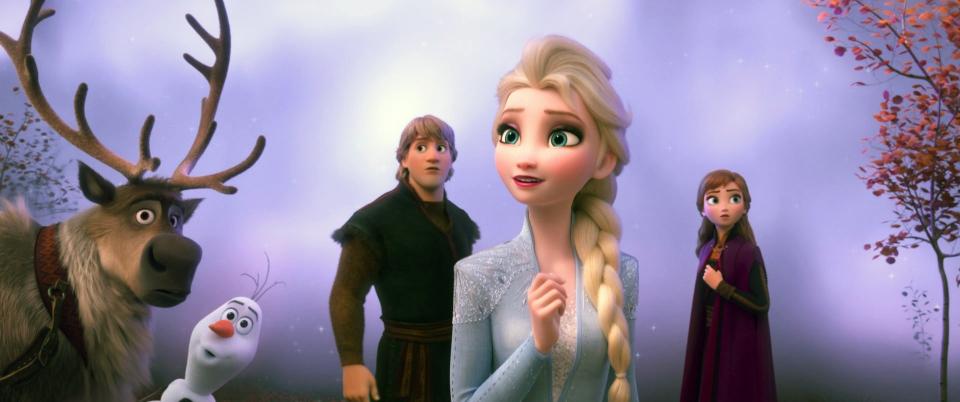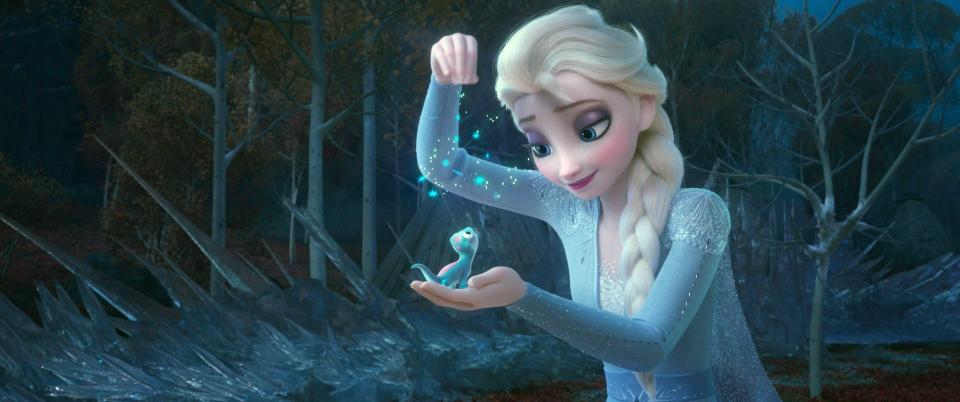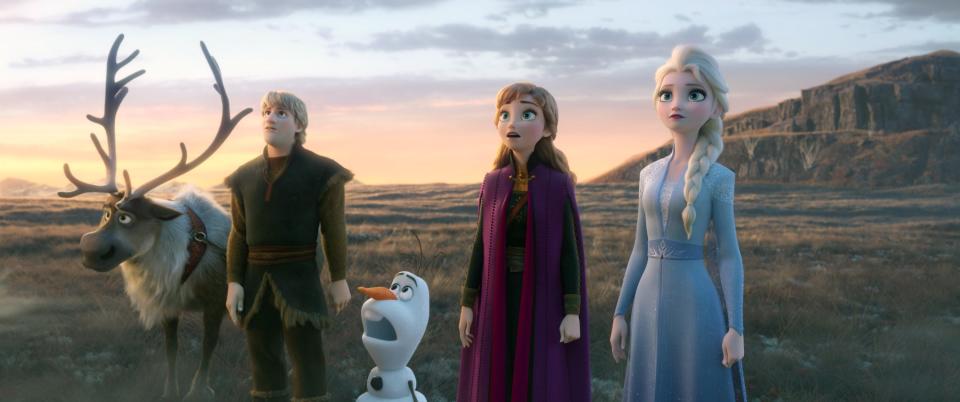Frozen 2 Will Satisfy (Most) Fans of the Original
Hey, reader! If you’re SO ready for Frozen II, take a look at the film's swag for your whole family in our new shopping tool: In any Glamour story featuring a shopping bag icon, you can instantly shop a selection of related products, curated by us. Check out our picks to your left on desktop and right on mobile. Happy shopping!
In 2013, Disney’s mega-hit Frozen introduced us to Elsa of Arendelle, a magical, moody, closed-off, and fearful princess of a Nordic kingdom who became queen and immediately (accidentally) set off an eternal winter. She pushed away everyone who loved her, including her own sister, Anna, because she was scared of hurting people with her powers. Instead, she preferred to live alone in a faraway ice castle where she could change her outfits, play with her hair, and strut around as much as she wanted. Sure, she almost killed everyone with her emotions, but she also, ultimately, saved the day with her emotions, learning along the way to embrace what made her different. Oh, there was a talking snowman in the mix too.
In Frozen 2, now in theaters, Elsa’s gained control of her ice powers, but that doesn’t mean she’s comfortable living in royal domesticity. She hears the call of the wild—a woman’s voice singing to her from somewhere out in nature—and longs to once again let it go and strike out on her own for an adventure.
To save the day (again) Elsa pushes away the people who love her (again), changes her hair and her outfit several times, and learns more about what makes her different and special. Also, the talking snowman is back. It’s not a beat-for-beat rehash of the original, but if you came to this review to answer the question of whether or not you'll like Frozen 2, the answer is, well, did you like Frozen? Because Frozen 2 is more of the stuff that was in Frozen, for better or worse, whatever that means to you. For me, it means it lived up to my expectations. I found Frozen 2 exciting, gorgeous, compelling, and even inspirational.
Warning: Spoilers ahead.
The plot, much more convoluted than it needs to be, involves Elsa, Anna, Kristoff, Sven, and Olaf journeying north from their home country, Arendelle, to an enchanted forest that has been covered in an impenetrable mist for over 30 years. When a series of quasi-natural disasters forces the people of Arendelle to evacuate the kingdom, Elsa realizes the trouble comes from the upset spirits (Earth, Wind, Fire, Water). It’s all related to a story about the aforementioned mist-covered land the girls heard from their father. So once again, to fix the weather, they’re headed out of town to confront magic.

MCDFRTW WD014
© Walt Disney Studios Motion Pictures / courtesy Everett CollectionBut this time they also have to figure out the truth of the past, right the wrongs of the past, discover where Elsa’s magic comes from, learn what really happened to their parents, appease mystical spirits, and make peace between Arendelle and the Northuldra tribe, a peaceful, nature-worshipping people living in isolation because of the magical mist. Thanks to the plot device of water having memory (okay), all of this and more is revealed through ice sculptures. Along the way, the movie delivers a message about colonialism and/or reparations and/or genocide. At the start of the movie, for example, the people of Arendelle are gathering for what looks like a fall-themed harvest meal, a little like Thanksgiving. But then, through flashbacks and visions, we learn this culture also has its own history with tricking and slaughtering native people. So, again, a little like Thanksgiving.
Reckoning with one’s past is a noble goal for a Disney film, especially when it involves powerful heads of state like Elsa and Anna, but these complicated plot machinations lack the elegant simplicity of most fairy-tale stories. The villain here is Elsa and Anna’s grandfather, whom neither knew because he died before they were born—convenient!—saving the movie from the tricky task of having the women confront their racist grandpa about his murderous, xenophobic ways. The previous war between Arendelle and the Northuldra tribe was started under false pretenses when the king of Arendelle betrayed the Northuldra leader—but since the people responsible for starting the war are all gone now, there’s no one around to punish, just a situation to rectify.
The sisters learn that their mother was Northuldra, again saving Frozen 2 from the tricky task of investigating whether or not these two, having been raised in privilege, might have a little latent prejudice inside. Olaf, meanwhile, is on the bizarre but sometimes charming journey of reckoning with age, change, and his own mortality. The only person with a remotely straightforward task to accomplish is Kristoff, who more or less spends the movie following Anna around waiting for the right time to ask her to marry him. He also saves her life a couple times, but not in a problematic way, IMHO.
All of this exposition and clunky world-building is, thankfully, unnecessary to understand the wonderful action set pieces and showstopping songs that are probably why you bought/will buy a ticket in the first place. Elsa belts her heart out on two occasions, “Into the Unknown” and “Show Yourself,” while Anna sings the plucky “The Next Right Thing,” a more grown-up “Tomorrow” from Annie. Kristoff’s song, “Lost in the Woods,” is there for the parents, a Journey-style eighties power ballad accompanied by a silly music video that references ABBA and Queen. It’s “Agony” from Into the Woods, for people who have seen Glee, and it put a huge smile on my face. Olaf’s song, “When I Am Older,” is as ironic and weirdly cynical as “In Summer” from the first movie. But the snowman redeems himself a few scenes later when he quickly recaps the events of Frozen in a one-man show that’s honestly funny.

MCDFRTW WD013
© Walt Disney Studios Motion Pictures / courtesy Everett CollectionIn addition to an extra song, Elsa is given the full Gandalf treatment (i.e., she falls into a cave and journeys through space, time, and death, and comes out the other side in a white outfit riding a magical horse). Elsa’s a ball of anxiety, wracked with grief and guilt over the death of her parents, too shy to be queen or even play charades with her family. But when she finally gets away from Anna’s constant feelings check-ins, she’s also strong and brave and determined. In a long, nearly wordless sequence, Elsa runs headfirst into a raging, stormy sea, again and again, nearly drowning but eventually conquering the waves and the aforementioned magical horse. (He’s made of water, and he’s really cool-looking.) The scene was very much in the vein of the “get knocked down, get back up” motif in Captain Marvel. In fact, Elsa’s whole journey this time around is less “Let It Go” and more “Higher, Further, Faster.”
But the most powerful moment in the movie has to be “Show Yourself,” which finds Elsa journeying through a gorgeous crystal cave while begging the mysterious spirit whose voice she's been hearing to, well, show itself. Really, it’s about being vulnerable. And underneath that, it’s maybe-probably-possibly about being gay? It struck me as a nod to those who have been speculating about Elsa’s sexuality ever since Frozen was released. Onscreen she seems totally uninterested in anything romantic, but is that because she hasn’t found the right girl? The first movie can be read as a coming-out narrative, with Elsa revealing her true self to a populace that is at first angry but ultimately accepting. And there was that half-second of a two-dad family!

MCDFRTW WD006
© Walt Disney Studios Motion Pictures / courtesy Everett CollectionSo when trailers and plot hints began dropping for this sequel, fans were keen on Elsa getting a girlfriend. I’ll tell you now, Disney kind of copped out on this one. The Fire demon is an adorable baby lizard, not a hot power lesbian. We do see a young Elsa acting grossed out by her little sister’s hetero fantasies, but that could mean anything. And when we meet Honeymaren, a young Northuldra woman who explains a small plot point about a fifth element to Elsa as they sit amicably by a fire, they are separated by a baby reindeer. It’s a classic have-your-cake-and-eat-it-too move: Die-hard Elsa-is-a-lesbian theorists technically got a character who might, if they want to see it that way, be her girlfriend. But there’s still plausible deniability, likely to appease homophobic parents who don’t want to have their kids see anything remotely depicting a same-sex relationship. Maybe this is a baby step toward progress—or maybe Elsa is simply too busy saving the kingdom to even think about her own desires—but I found it a little wishy-washy. It’s all the more important, then, that “Show Yourself” exists. Like “Reflection” from Mulan, it’s destined to become a go-to torch song, an anthem of self-acceptance.
The ending wants to have it both ways too. But this is a movie for children, so that can be forgiven. In addition to all the themes previously mentioned, there’s also a climate change allegory here, in which a series of natural disasters threaten to destroy Arendelle because, basically, Mother Nature is pissed off. Anna, remarkably, comes to the conclusion that it’s okay to destroy society to fix the environment—but Elsa’s magic means they can restore harmony to the elements without flooding a single building. It’s The Green New Deal: Fjord Edition.
This, personally, is what resonated most with me. Elsa, Anna, and even Olaf are absolutely certain there is no future. The past was worse than they realized, and the present is changing too quickly to control. They used to have some level of certainty, but all of that is gone now. Totally freaked out, Anna asks one of the rock trolls what to do; he tells her that when you can’t see the future, all you can do is the next right thing. Later, separated from Kristoff and believing both Elsa and Olaf to be dead, Anna repeats this mantra in song. She can’t fix the whole world, or even most of it, but she can do the next right thing, and then the next right thing after that. I have to admit, I’d never thought of that before.
As democracy crumbles, the air turns to poison, and so many injustices are perpetrated around the world daily, I’ve also felt hopeless, lost, and alone. I’ve marched and donated and tried to shop ethically. But I’m no crusader, and I’m often not sure whether my actions matter in the long run, since we’re all going to die in however many years. Until Frozen 2, I’d never heard it put so succinctly and clearly: Just do the next right thing. It’s not about hope or righteousness or some other lofty, intangible aspiration. Just do the next right thing. I admit I’m a little embarrassed to say it, but Frozen 2 taught me an important lesson.
In the theater I sat next to a father and child who must have been very young when the first Frozen came out. The moment the credits started, the kid gave the following review: “It was much longer, and there were more songs.” Actually, Frozen 2 is about the same length as Frozen, with the same number of songs. But this kid got more out of it—and who am I to argue with that?
Lizzie Logan is a comedy writer living in New York City. You can find more of her work at lizzielogan.com or by following her @lizzzzzielogan on Twitter and Instagram.
Originally Appeared on Glamour

